


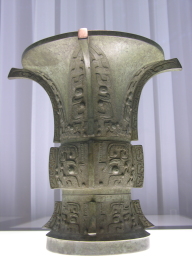




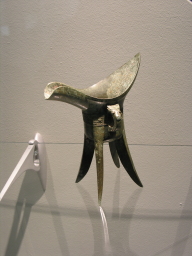








I thought it was for gravy, the catalogue said water. 7th Century BC.



This one was for cowrie-shells.


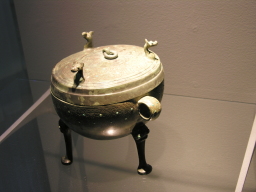
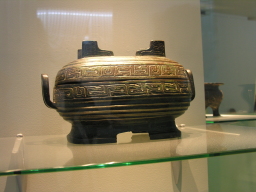

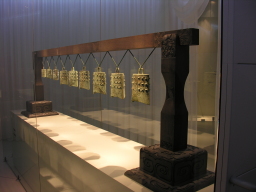
A chinese glockenspiel, from the 7th century BC.



You can enlarge the photos in this page by putting the mouse cursor on the picture. Moving the mouse off the picture makes it revert to the smaller thumbnail.
You will probably want to scroll the window so each small photo is at the top of the screen before you put the mouse on it. Otherwise you only see the top part of the large photo. If you find this irksome, you can load a page with all the photos full size here, but be aware the download will take much longer, as each of the pictures is about 4 times as big as the thumbnails.
I had always been keen to see the exhibition of the Chinese terracotta warriors, and had always managed to miss seeing them in London. So we were pleased to discover there was to be a double headed exhibition, the warriors in Assen, and a selection of the bronze treasures that belong to the Shanghai museum in Groningen. We bought our tickets in advance on the Internet, and set out at sparrow fart (Groningen is 2 and a half hours by train from Amsterdam).
We started with the bronzes in Groningen. They are quite spectacular, considering that the latest of them is more than 2500 years old. Unless indicated otherwise, the objects were wine or food containers. No way can I remember all the dates, but some of the early shots are of objects made in the 16th Century BC.

















I thought it was for gravy, the catalogue said water. 7th Century BC.



This one was for cowrie-shells.






A chinese glockenspiel, from the 7th century BC.



Having wisely begun early, we got through the bronzes much faster than we had anticipated. Just as well, because it was National Visit As Many Possible Museums In The Weekend weekend, and there were an awful lot of people arriving as we left. Sowe had a couple of hours to kill before our planned train from Groningen to Assen. Groningen has lots of churches. This, though, isn't one of them. It turned out to be a synagogue, built in the early 20th century, in the modern Byzantine style (the cupolas, I suppose), with Mozarabic influences. The door to the Rabbi's house is a perfect Mozarabic arch.

Lots of olde-worlde buildings.


The Aa church. It was the parish church of Our Lady of Aa, but the protestants shortened the name, perhaps for fear of mariolatrous connotations.
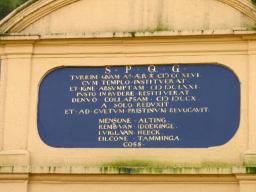
A memorial to those who restored the tower in (I make it) 1710, after it had been destroyed by fire after a lightning strike.

Empty shopping streets. Everyone in town is visiting the museum or the market.

Six days shall you labour, and on the seventh you shall shop.

The tower of the improbably named Martini Church. This tower is supposedly one of the five highest in The Netherlands, and I don't want to climb any of the other four.

Looking back to the tower of the Aa church. Sounds like quite a good combination of church names, really. The real story is that Groningen belonged to the diocese of Utrecht for a long period in the Middle Ages, and that diocese was under the patronage of St Martin of Tours.

Looking down the side of the Martini Church, towards buildings which seemingly are part of the regional administration.

Now on the first balcony of the Martini tower, looking towards the south, and an an unidentified church tower.
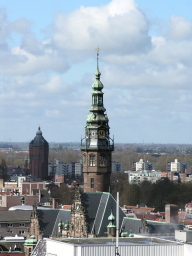
This tower is part of the provinciehuis - the regional administration.

Traditional Dutch facades on the Grote Markt.

The Aa church. This taken from the second level of the tower. I then climbed up to the third, where there was someone demonstrating how you could play tunes on the bells, using a keyboard instrument looking rather like an organ. Too little space, and too many tourists, for any photographic proof.

The "Gold House" - originally the collection point for taxes.

Unlike Keble, this is not magnifique, but it is the station.
Assen is an altogether smaller place than Groningen. Lots of picture postcard houses like this:

At last, the moment I had been waiting for. What a scrum there was in the museum! The museum is quite small, and it felt as though the whole country was celebrating National Museum Weekend (did I mention that more than 450 museums were admitting people free or at a discount?). It would have been quite impossible to shoot some of the earlier, smaller, exhibits as a result. You can see how crowded it was towards the end of this sequence. The first surprise was the fact that there warriors, and figures of other people, of several different sizes. We approached the life (or over-)size figures from above and behind.


This is the least blurred of the shots I could take in the horizontal plane. I needed a gripper mini-tripod.

Dwarfing the Dutch. See what I mean about oversize?

This cabinet contained many different animals. Hens in front, followed by horses, buffalo or oxen in the background. You can see how busy it was ...

I couldn't get at the place I needed to to capture the pigs' faces, but they were very naturalistic - including the wrinkles over they eyes.

Same problem with the dogs.

Our warriors in serried ranks assemble .... this case makes it plain how much of a manufacturing approach the emperors' servants took to producing the tomb figures.

One last shot of the big figures

Last exhibit - armour.

hope you enjoyed these photos as much as we enjoyed the exhibitions.